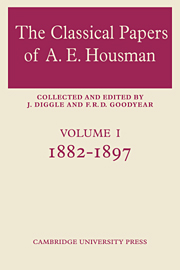Book contents
- Frontmatter
- Contents
- Preface
- List of editions consulted
- Abbreviations
- 1 Horatiana 〚I〛
- 2 Ibis 539
- 3 On Soph. Electr. 564, and Eur. I.T. 15 and 35
- 4 On certain corruptions in the Persae of Aeschylus
- 5 Isocr. Paneg. §40
- 6 Schol. on Aesch. P.V. 488 〚472〛
- 7 CωφPONH
- 8 Emendationes Propertianae
- 9 The Agamemnon of Aeschylus
- 10 Note on Emendations of Propertius
- 11 Horatiana 〚II〛
- 12 Notes on Latin poets 〚I〛
- 13 Persius III. 43
- 14 Conjectural emendations in the Medea
- 15 Review: T. G. Tucker, The Supplices of Aeschylus
- 16 Review: I. Flagg, Euripides' Iphigenia among the Taurians
- 17 Horace, Carm. iv. 2, 49
- 18 Notes on Latin poets 〚II〛
- 19 Horatiana 〚III〛
- 20 Emendations in Ovid's Metamorphoses
- 21 The new fragment of Euripides
- 22 Adversaria orthographica
- 23 The Oedipus Coloneus of Sophocles
- 24 Sophoclea
- 25 Remarks on the Vatican Glossary 3321
- 26 Soph. Oed. Col 527
- 27 The manuscripts of Propertius 〚I〛
- 28 The manuscripts of Propertius 〚II〛
- 29 Review: K. P. Schulze, Catulli Veronensis liber
- 30 The manuscripts of Propertius 〚III〛
- 31 A note on Virgil
- 32 The manuscripts of Propertius 〚IV〛
- 33 Review: J. P. Postgate, Sexti Properti carmina
- 34 Cicero Pro Milone c. 33 §90
- 35 Ovid's Heroides 〚I〛
- 36 Ovid's Heroides 〚II〛
- 37 Ovid's Heroides 〚III〛
- 38 Ovid's Heroides 〚IV〛
- 39 Ovid's Heroides 〚V〛
20 - Emendations in Ovid's Metamorphoses
Published online by Cambridge University Press: 15 March 2010
- Frontmatter
- Contents
- Preface
- List of editions consulted
- Abbreviations
- 1 Horatiana 〚I〛
- 2 Ibis 539
- 3 On Soph. Electr. 564, and Eur. I.T. 15 and 35
- 4 On certain corruptions in the Persae of Aeschylus
- 5 Isocr. Paneg. §40
- 6 Schol. on Aesch. P.V. 488 〚472〛
- 7 CωφPONH
- 8 Emendationes Propertianae
- 9 The Agamemnon of Aeschylus
- 10 Note on Emendations of Propertius
- 11 Horatiana 〚II〛
- 12 Notes on Latin poets 〚I〛
- 13 Persius III. 43
- 14 Conjectural emendations in the Medea
- 15 Review: T. G. Tucker, The Supplices of Aeschylus
- 16 Review: I. Flagg, Euripides' Iphigenia among the Taurians
- 17 Horace, Carm. iv. 2, 49
- 18 Notes on Latin poets 〚II〛
- 19 Horatiana 〚III〛
- 20 Emendations in Ovid's Metamorphoses
- 21 The new fragment of Euripides
- 22 Adversaria orthographica
- 23 The Oedipus Coloneus of Sophocles
- 24 Sophoclea
- 25 Remarks on the Vatican Glossary 3321
- 26 Soph. Oed. Col 527
- 27 The manuscripts of Propertius 〚I〛
- 28 The manuscripts of Propertius 〚II〛
- 29 Review: K. P. Schulze, Catulli Veronensis liber
- 30 The manuscripts of Propertius 〚III〛
- 31 A note on Virgil
- 32 The manuscripts of Propertius 〚IV〛
- 33 Review: J. P. Postgate, Sexti Properti carmina
- 34 Cicero Pro Milone c. 33 §90
- 35 Ovid's Heroides 〚I〛
- 36 Ovid's Heroides 〚II〛
- 37 Ovid's Heroides 〚III〛
- 38 Ovid's Heroides 〚IV〛
- 39 Ovid's Heroides 〚V〛
Summary
237–9
fit lupus et ueteris seruat uestigia formae.
canities eadem est, eadem uiolentia uultus,
idem oculi lucent, eadem feritatis imago est.
The eyes of a homicide transformed into a wolf may well be said to flagrare, ardere, scintillare or the like, but ‘lucent’ is quite inadequate and should I suspect be replaced by ‘lurent’. The adjective ‘luridus’ is of course common, the substantive ‘luror’ very rare, the verb ‘lureo’ unknown to lexicographers: once however it has been preserved, and that once in the metamorphoses. At 11 776 our MSS give ‘nusquam recta acies, liuent rubigine dentes’; but this verse is found by Mr Ellis in a Bodleian codex of excerpts (MS Digby 65, saec. XII) with ‘lurent’ for ‘liuent’, and not only is it intrinsically improbable that the unique word should be a corruption of the common one, but ‘lurent’ is supported by Hor. carm. iv 13 10 ‘luridi dentes’. Again in Plaut. Menaech. 828 ‘uiden tu illi oculos uirere? ut uiridis exoritur colos’ cet., where ‘uirere’ cannot well be right with ‘uiridis’ following and one MS gives ‘iurere’, Ritschl has conjectured ‘lurere’. Once more, in Sen. Herc. fur. 766 sq. Charon is thus described: ‘inpexa pendet barba, deformem sinum ∣ nodus coercet, concauae lucent genae’ (for ‘lucent’ one family of MSS has ‘squalent’, but that comes from ‘squalidus’ in 765): here again the verb is miserably weak, especially if compared with Virgil's ‘stant lumina flamma’, and here too I propose ‘lurent’.
Information
- Type
- Chapter
- Information
- The Classical Papers of A. E. Housman , pp. 162 - 172Publisher: Cambridge University PressPrint publication year: 1972
